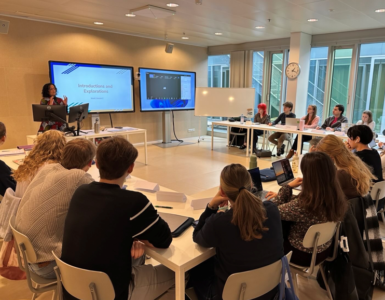As we crawl out of the coronavirus pandemic that brought so much death and destruction to our world as we knew it, that exacerbated inequalities and the digital divide, and forced innovation and ingenuity, we know that we can’t let these experiences be in vain. We have to acknowledge the pain, reflect upon the opportunities we took advantage of, and keep the changes that added value and efficiencies to our lives. One of the key lessons learned during this time is that online learning experiences can and should offer quality learning and provide a life-long impact. The use of videoconferencing systems that meet specific learning and teaching needs are contributors to this quality. I recently wrote a blogpost that examines questions around the quality of online learning experiences that specifies seven principles to create an exceptional online learning experience.
As online learning becomes more applied to the real-world and connected with the learners’ professionals and life experiences, the importance of using an experiential learning framework when teaching online becomes imperative. Experiential learning allows learners to apply what they are learning to new situations and to learn by doing.
When evaluating videoconferencing systems for the quality of the educational experiences, four widely used videoconferencing systems – Zoom, Skype, Microsoft Teams, and WhatsApp – were analyzed. This analysis was performed by looking at the systems through an experiential learning framework. The criteria followed to identify which videoconferencing systems to analyze, including offering a free version or free trial for users; being available in both web and application versions; being updated; being prevalent and widely used, and have been used in educational contexts.
As we envision innovative videoconferencing systems to support high-quality educational experiences and the evolving needs of online and life-long learners, new features need to be reimagined and optimized. The following paragraphs discuss features of the next generation of videoconferencing systems to support high-quality educational experiences.
Increase leaners’ privacy and security
Videoconferencing systems need to improve privacy and security features and offer high reliability when it comes to protecting participants’ real identities. Learners’ privacy and security are critical as new systems strive to protect users’ personal information, information, and data from unauthorized persons or systems. For example, Zoom provides the highest level of end-to-end encryption. A specific identifier and password can be created for each meeting, and the host of the meeting has the authority to decide who can join in the meeting and when. However, in WhatsApp, because users can have audio or video calls only with people in their contact list, there are no extra protective settings for each meeting.
Offer outstanding customer technical support
Customer technical support is treated as a given in today’s flooded marketplace, but the quality and reliability vary wildly across next generation systems. This is a critical piece of the online learning puzzle. Videoconferencing systems should offer different modes to access help at all times (e.g., chat with a real agent), short timeframes between identification of the issue and solving it, and personalized, friendly and respectful interactions with the customers. Since these systems serve a global audience, services in different languages and time zones should be offered and easy to locate on the platform.
When compared with Microsoft Teams and WhatsApp, the higher levels of satisfaction experienced by users of Zoom and Skype are due to the quality of the customer service support. Zoom and Skype offer different ways to get assistance, the service is timely, and the interaction is friendly. Regarding customer service support, Microsoft Teams and WhatsApp show room for improvement when it comes to solving customers’ specific issues with the systems in an effective and timely fashion.
Maximize the integration of third-party applications
As videoconferencing systems evolve and collaboration becomes the hallmark of the post-pandemic era, more capabilities to integrate different applications will need to be available to make these systems more competitive. For example, augmented video applications that allow for the use of filters, image manipulation, high-quality still, and animated, special effects virtual backgrounds.
Currently, Zoom, Skype, Microsoft Teams, and WhatsApp integrate SnapCamera, which is a free desktop application that uses filters for image manipulation. Additionally, Zoom, Skype, and Microsoft Teams have added captioning for talks in different languages, which can effectively solve accessibility issues and language barriers. Integrating these types of features adds value to the user’s experience and allow them to focus on their learning experience rather than running a multitude of technical systems to meet their needs.
Expand the systems to incorporate social media features
The user interaction with audio and video is central for the online learning experience when using videoconferencing systems. Audio (mute), video (turn off camera), recording and playback, screen and application sharing, remote control (allow one specific user to access the system remotely and make selections, edits, and other modifications to the shared screen), file transfer, chat, annotation tools, breakout rooms, polling and question and answers capabilities, virtual hand-raising, instant reaction, and captions are some of the main features that support learners and instructors. Next generation videoconferencing systems would expand to embed social media social applications such as Facebook, Instagram, Twitter, and other interactive technologies, like video games and video-sharing apps (e.g., TikTok). The integration of these apps will offer different levels of interaction and a continuation of the discussion or interaction beyond the duration of the “live” videoconferencing events.
This article has been inspired and adapted from: Correia, A.-P., Liu, C., & Xu, F. (2020). Evaluating videoconferencing systems for the quality of the educational experience. Distance Education, 41(4), 429-452.

Author
Ana-Paula Correia, PhD
Ana-Paula Correia is an associate professor of learning technologies and the director of the Center on Education and Training for Employment at The Ohio State University, Columbus, USA. Correia’s research is focused on learning technologies, learning design, and curriculum development.














